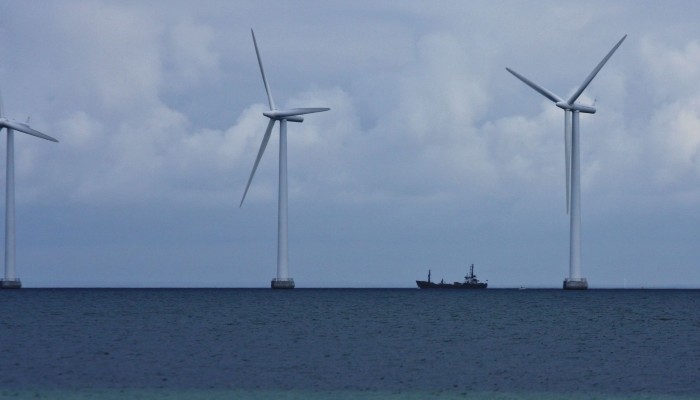
Porpoises aid biologists in protecting marine animals
Marine mammals are increasingly being disturbed by human activities at sea. Now, two young porpoises are set to help researchers gain essential insight in how to best protect marine mammals from man-made noise and disturbance.
The sea is no longer the calm habitat it used to be.
– Man-made sounds can disturb marine animals, and this is a well-known problem for animals such as porpoises, says Magnus Wahlberg, a biologist and expert in marine mammals at the University of Southern Denmark (SDU).
Examples of man-made noises that can disturb marine animals can range from the construction of offshore wind farms and oil/gas exploration to shipping traffic, jet skis and military sonar.
 How much noise can porpoises and other marine animals tolerate? This is important to know when constructing new offshore wind farms, for example. Photo: Colourbox.
How much noise can porpoises and other marine animals tolerate? This is important to know when constructing new offshore wind farms, for example. Photo: Colourbox.
– We need to learn more about how marine animals are affected by human-made noise – at what point does their hearing or ability to hunt for food deteriorate? How can we prevent animals from ending up in fishing nets as by-catch? How far away should the porpoises be when establishing offshore wind turbines, or when detonating ammunition which has been lying on the seabed since World War II? Such knowledge requires that research be conducted in controlled environments, especially when addressing questions about animal hearing. Based on this knowledge, it’s possible to create noise-free and sometimes even porpoise-free zones in the areas where you’re making noise, so that the animals are spared from the noise, says Magnus Wahlberg.
To learn more about this, researchers from multiple universities, including SDU, are collaborating with Fjord&Belt, which recently received two young porpoises that had been accidentally caught in fishermen's nets.
Read more about Fjord&Belt’s two new porpoises (in Danish)
The work with the two porpoises will be an extension of the work which SDU's biologists have focused on for a number of years: collecting data on the animals' hearing, sound production and the use of echolocation for orientation.
The researchers also use drones to study the porpoises’ social behaviour, hunting behaviour and behaviour between mother and calf at sea. All of this work is based on the research being done at Fjord&Belt.
 When the porpoises’ echolocation abilities are investigated, their eyes are covered by suction cups to prevent them from ‘cheating’. Research shows that the porpoises’ hearing is negatively affected at surprisingly low noise levels. © Solvin Zankl , Fjord&Belt.
When the porpoises’ echolocation abilities are investigated, their eyes are covered by suction cups to prevent them from ‘cheating’. Research shows that the porpoises’ hearing is negatively affected at surprisingly low noise levels. © Solvin Zankl , Fjord&Belt.
– There are ample good opportunities for us to study marine animals in their own, free environment. But before we can, for example, put measuring equipment on a wild porpoise – to gain the necessary knowledge about, for example, their hearing abilities – we need to develop the actual equipment. We always start with trained animals, because it allows researchers to optimise design and data collection methods in detail. Research on trained porpoises is absolutely crucial to be able to conduct some of the research that is relevant for the conservation of wild animals, says Magnus Wahlberg.
He further points out that Fjord & Belt is the world’s best-suited facility for keeping porpoises and conducting research on them.
– The animals swim in a facility in Kerteminde harbour, where fresh seawater flows through. The acoustic conditions are excellent, he says.
Kirstin Anderson Hansen is a biologist at SDU and an expert in animal behaviour and welfare. She trains the animals to collaborate with researchers.
According to her, the porpoises at Fjord&Belt are doing well and show no signs of stress or bad welfare. They are curious, active and continuously stimulated, and they are constantly monitored for so-called stereotypical behaviour, i.e. unnatural repetitive behavioural patterns.
– The porpoises are displaying the same behavioural repertoire as wild porpoises. We’re able to measure their stress hormones from blood samples, which allow us to detect whether or note they are stressed. The porpoises at Fjord&Belt maintain low levels of these stress hormones.
In addition to porpoises, SDU's biologists are working with various other marine animals, including seals, guillemots, penguins, cod and cormorants.
The researchers' work with porpoises and other marine animals is published regularly in scientific journals. Some of the publishers who publish the scientific articles charge a fee for access to the articles, so not all of the scientific articles published by our researchers are available for free.
View a list of scientific articles from SDU's Marine Biological Research Centre
Contact
Magnus Wahlberg is a biologist, associate professor and the day-to-day head of SDU's Marine Biological Research Centre.
Contact
Kirstin Anderson Hansen is a biologist and animal trainer at SDU's Marine Biological Research Centre.